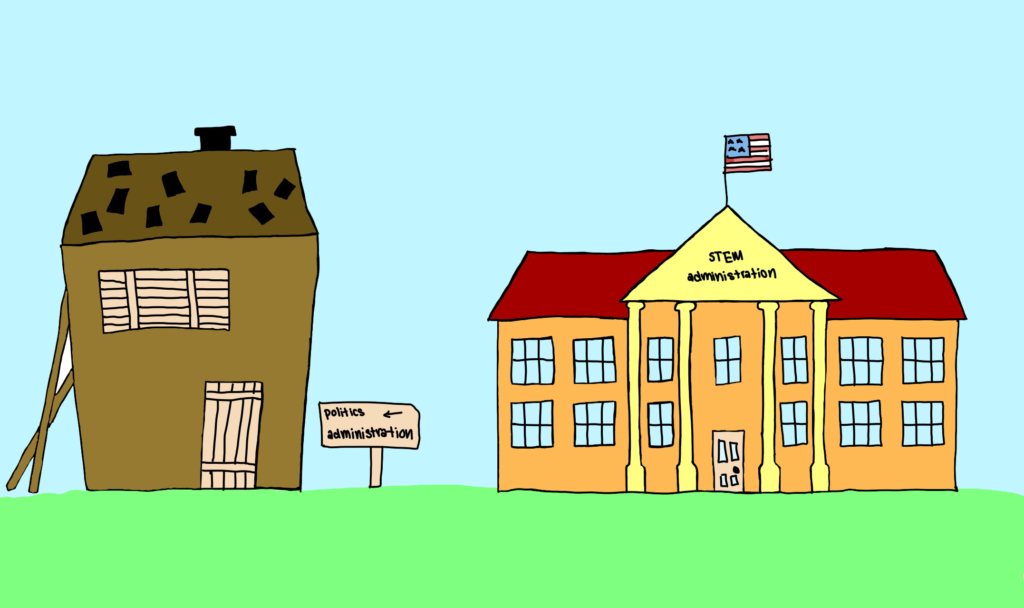Before the pandemic, if you took a quick walk around campus, you’d notice dozens of students frantically studying for their next science test, future engineers building complex robots or members of a coding club working together.
This image paints a clear picture of what Saratoga High is: a mostly STEM-focused school since most students aim to pursue college majors and jobs in those fields.
While there’s nothing wrong with a school catering to the majority’s interests, the school must do its best to remove obstacles for students seeking a career in other fields. Saratoga High needs to make it easier for non-STEM students, particularly those interested in business and politics, to take fundamental classes earlier, so they can pursue high-level opportunities like STEM students do.
Because there are few opportunities for business and political students at Saratoga High, the school naturally sees less interest from these students, in turn making the school more disinclined to create more programs for them. If the school takes a leap of faith and creates new programs for those interested in business and politics, they would be taking the first step towards breaking this vicious cycle.
For students striving for careers in business or entrepreneurship, the lack of business classes offered at the school may set them behind their peers at other schools that do offer such courses, like Lynbrook and Harker.
Currently, the school offers two business-related courses: Introduction to Business and AP Gov/Econ. Lynbrook, on the other hand, offers five business courses — including a business simulation class and multiple levels of accounting — providing significantly more opportunities to delve into the field. (Lynbrook has the advantage of having 1,880 students compared to Saratoga’s 1,290, but still offers more classes per student).
Saratoga High should make a greater effort to create additional opportunities for students interested in economics. Of course, it wouldn’t make sense to introduce new courses if nobody wanted to take them, but considering the popularity of the Toga Econ Club, which averages 40 members per bi-monthly meeting, demand is strong. The relative success of these clubs just signifies that many are interested in learning economics and business but have nowhere else to go to learn.
This isn’t to say that the school hasn’t done anything to promote economics: Seniors have to study economics as part of their government/economics classes, and the school recreated the Introduction to Business elective just last year.
Still, two classes aren’t enough to properly explore the vast field of economics — especially considering that economics takes the backseat in AP Gov/Econ because students and teachers focus more on preparing for the AP Gov exam. The Introduction to Business course was a step in the right direction, but the course is what it sounds like: an introduction. After getting a taste of various economic concepts and financial strategies, students should be able to dive deeper into the world of business and economics, whereas right now, they lack such courses to do so.
That’s not to say that adding new courses would be easy. In fact, it would be incredibly difficult for the school to add new courses given a decreasing number of students attending the school — the school’s population decreased from 1,350 last year to 1,290 this year, resulting in a loss of participation within programs like MAP, drama and journalism. As such, a more viable course of action in the short term may be to shift curriculum in classes like AP Gov/Econ and various history classes to emphasize business and finance, in addition to curriculum already being taught.
Another problem arises with the way courses are placed throughout students’ careers.
Students complete required fundamental STEM classes in the early years of high school; most take biology and chemistry in their first two years. The math department allows students to choose their class based on their prior knowledge, so students may take Algebra II or PreCalculus in their freshman year. Computer science and engineering are electives that students can take whenever they want.
This system allows STEM students to gain basic knowledge of these subjects at an early stage. Since they’re mandatory, fundamental classes can and must be completed early, leaving STEM students with plenty of time to build on their knowledge and further their understanding.
But non-STEM students aren’t so lucky. Like business-inclined students, those interested in politics may only take U.S. Government and Politics as seniors. The only way for these students to gain the fundamental knowledge of these topics earlier in their high school careers is to take the classes outside of school — only to retake them in their senior year.
As such, the district would do well to give non-STEM students a way to take these classes at an earlier stage of high school. In addition to introducing new non-STEM courses, the school could also credit students for taking classes at schools verified by the University of California system and require that students prove their mastery over the material with exams to test out of the respective classes.
What the district should not do is continue to push SHS toward being not just a STEM-first school, but perhaps a STEM-only school. A school’s job is to help all of its students succeed, not just the students whose interests align with most others.


























